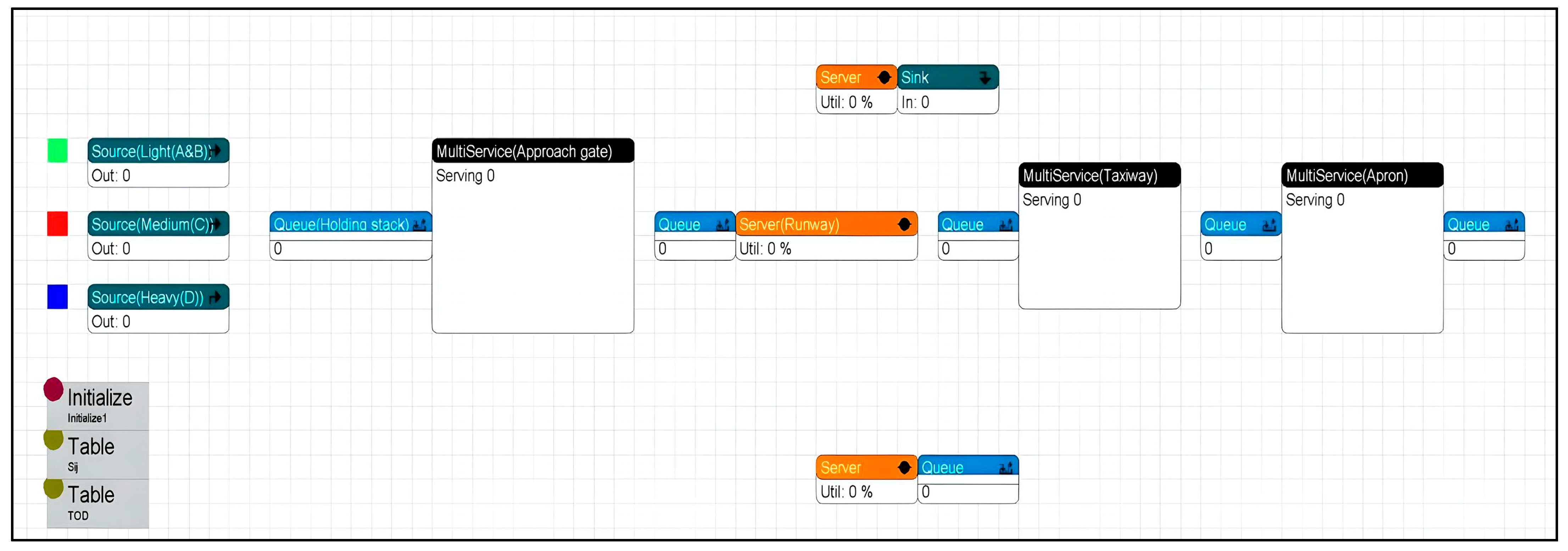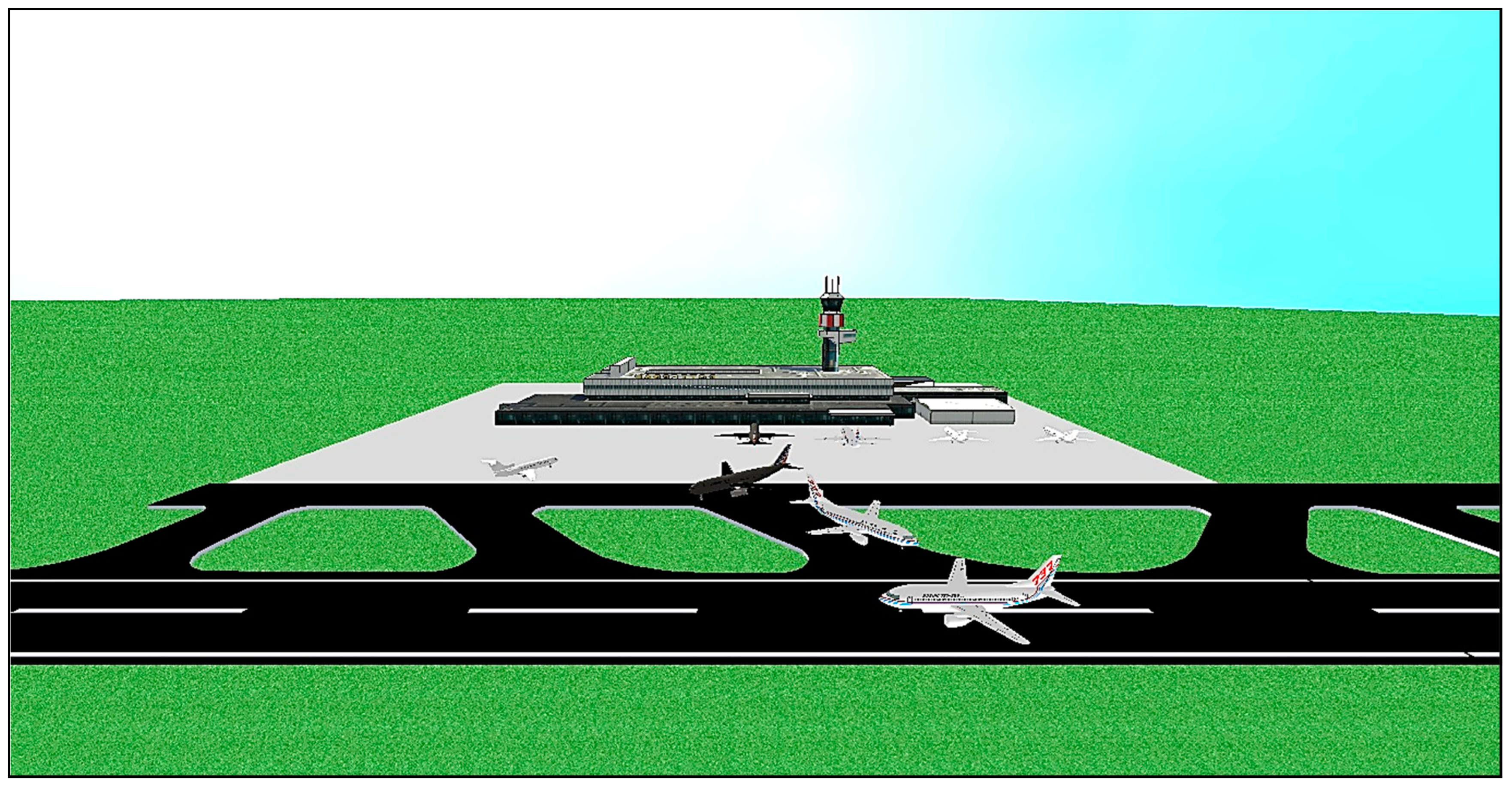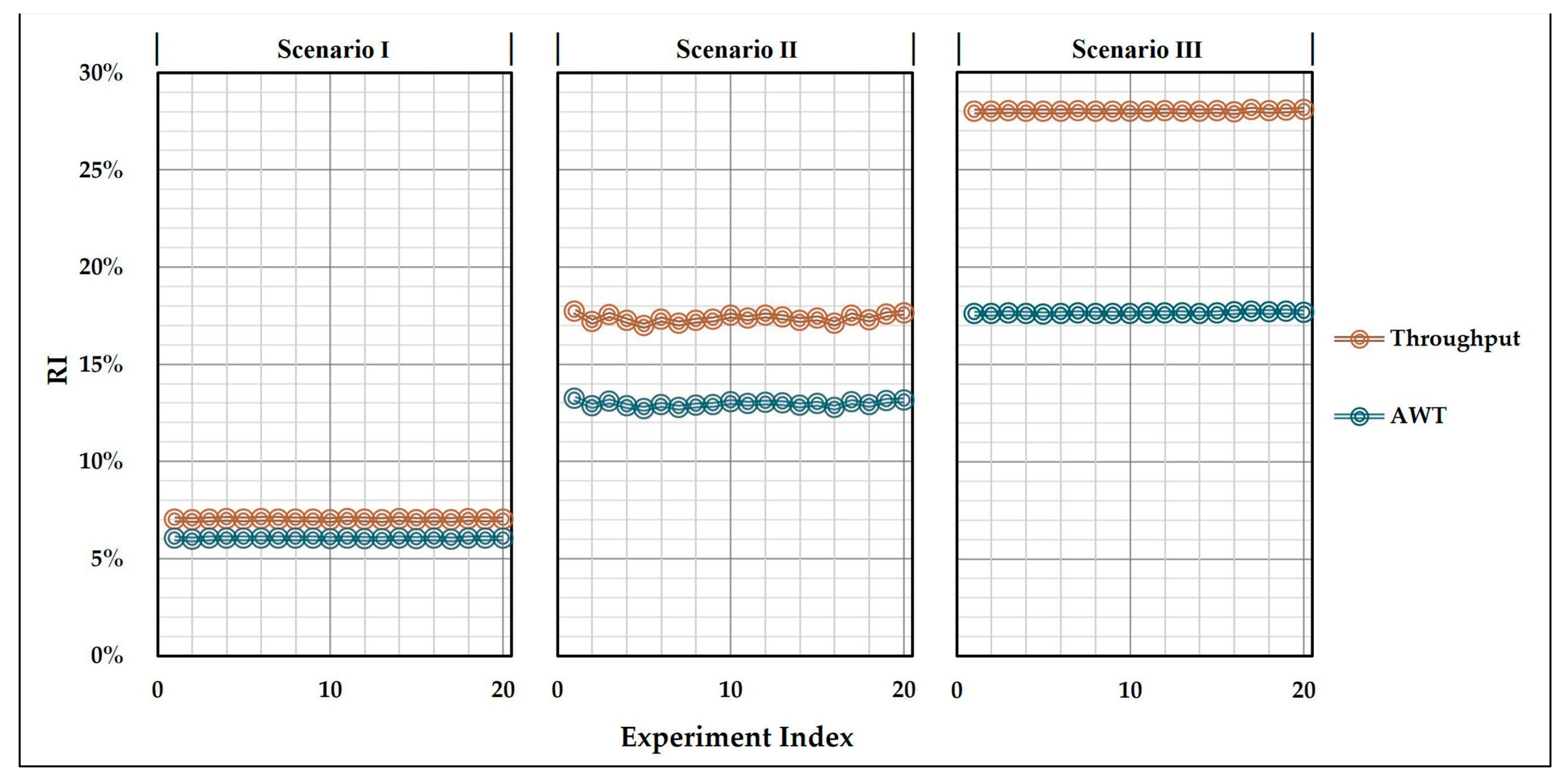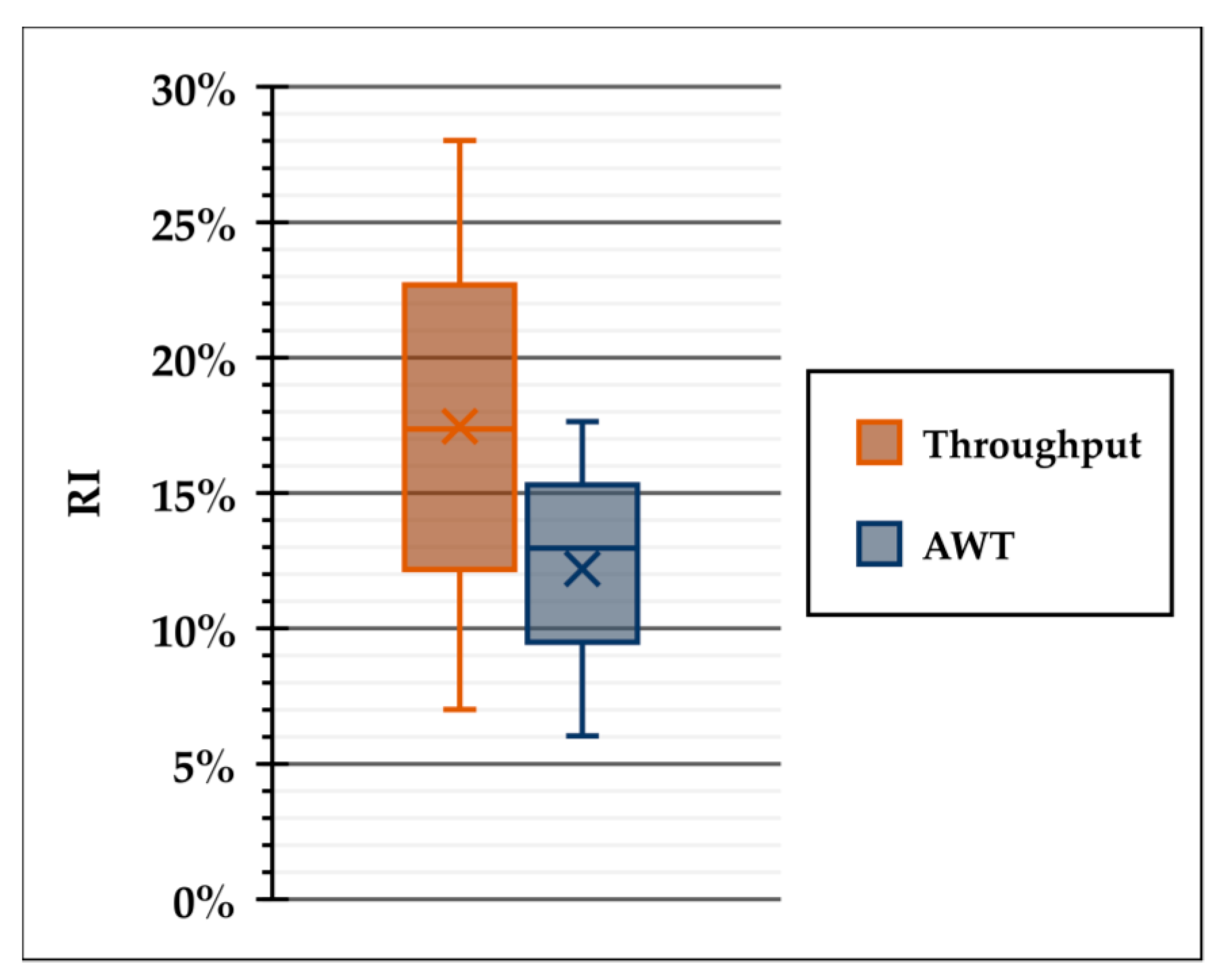Airside Optimization Framework Covering Multiple Operations in Civil Airport Systems with a Variety of Aircraft: A Simulation-Based Digital Twin
Abstract
1. Introduction
2. System Description
2.1. Airside Components
- (1)
- Holding stack: Holding (or flying a hold), in aviation, is a maneuver designed to delay an aircraft already in flight while keeping it within a specified airspace. A standard holding pattern can be seen in Figure 1.
- (2)
- Approach gate: It is an entry part beyond which the pilot cannot alter speed and direction (without a command or permission from the control tower).
- (3)
- Glide path: it is where all aircraft are sequenced individually under rules of minimum distance separation.
- (4)
- Final approach: A zone on the approach and in a specified distance from the runway threshold. Once an aircraft enters this zone on its landing operation, no other airplanes are allowed to enter the runway from the departure queue. In other words, despite the runway being empty, it is considered to be locked/occupied by the landing airplane until after its landing operation is complete.
- (5)
- Runway: A runway is a “distinct rectangular area on a land aerodrome prepared for the landing and takeoff of aircraft” [21]. Runways may be a man-made surface (often asphalt, concrete, or a mixture of both) or a natural one (grass, dirt, gravel, ice, or salt). As a dominant rule in this industry, each runway may be occupied only by one aircraft at a time.
- (6)
- Taxiway: A walkway made by asphalt, concrete, gravel, or grass that links the runways to the terminals, ramps, and other airport infrastructure assets [24]. Design of this part of the airport and proper management of the taxiways significantly influence the overall capacity of the runway [15,16,25,26].
- (7)
2.2. Airport Capacity
2.3. Apron Capacity
2.4. Delay
3. Simulation-Based Digital Twin
3.1. Attributes of the Aircraft
3.2. Control Tower Rules and Modeling Assumptions
- The system operates 24 h a day and 365 days a year.
- Landing events have preemption over departure operations. For all other cases (arrival–arrival or departure–departure events), only a FIFO (first-in, first-out) sequencing strategy is put in place with no preemptions.
- Only one runway is in operation, and at any point in time, one aircraft can occupy the runway.
- A departure operation may not be initiated if the subsequent arrival is less than a specified distance from the runway threshold, usually 2 nautical miles (NMI) in IFR conditions.
- Successive departures are spaced at a minimum time separation equal to their departure service time from Table 2. As an assumption, the freedom of the tower controller to reorder the immediate parts of the departure sequence is disregarded.
- To estimate the arrival–arrival minimum time separation over the approach path (i.e., ) for each pair of leading aircraft and trailing aircraft , the following rule from [21] is applied:where is the minimum permissible distance separation between the two arriving aircraft anywhere along the common glide path from Table 2, is the length of the common approach path, and is the runway occupancy time of the leading aircraft. The relatively short buffer time in this formula acts as a safety period applied by the control tower based on their expertise and the airport conditions. The speeds of leading and trailing planes are also symbolized by and , respectively.
- All planes that enter the airport have a two-way visit with a departure already scheduled for them, and no aircraft is expected to stay at the airport indefinitely.
3.3. Simulation Modeling
4. Implementation in an International Airport
- The common approach/glide path of this airport is 15 km in length, and the safety buffer time is 20 s.
- Based on the observed restriction on the operational teams, apron capacity is assumed to be independent of the type of aircraft. Apron capacity is 5 aircraft, and it is also independent of their type.
- Due to the prevailing weather conditions in the area where the airport is located, runway processes of both arrivals and departures are under the IFR conditions.
- Equipment and aircraft maintenance operations are assumed to be completely effective. Thus, no failure is expected during the analysis horizon.
- Changes in the direction and magnitude of wind are disregarded, i.e., the arrival and departure operations are performed in one direction only.
5. Scenario Analysis and Discussion
| Scenario I: | Adding another apron operating team to reduce their cycle times in loading and unloading, boarding and unboarding the passengers, stoking, inspecting, and other routine tasks. |
| Scenario II: | Adding two operational locations (i.e., gates) in the apron. |
| Scenario III: | Considering both workarounds from scenarios I and II simultaneously. |
6. Conclusions
Author Contributions
Funding
Data Availability Statement
Conflicts of Interest
References
- Qudrat-Ullah, H. Introduction: Managing Complex Tasks with Systems Thinking. In Managing Complex Tasks with Systems Thinking; Springer: Berlin, Germany, 2023; pp. 3–23. [Google Scholar]
- Siddique, I. Systems Engineering in Complex Systems: Challenges and Strategies for Success. Eur. J. Adv. Eng. Technol. 2022, 9, 61–66. [Google Scholar] [CrossRef]
- Marquez, V. Landside| Airside: Why Airports Are the Way They Are; Springer: Berlin, Germany, 2019. [Google Scholar]
- Skorupski, J. Airside and Landside Modelling for Determining Airport Capacity. Proc. MATH-MoD 2009, 9, 271–282. [Google Scholar]
- Yang, Z.; Yu, S.; Notteboom, T. Airport location in multiple airport regions (MARs): The role of land and airside accessibility. J. Transp. Geogr. 2016, 52, 98–110. [Google Scholar] [CrossRef]
- Di Mascio, P.; Moretti, L.; Piacitelli, M. Airport landside sustainable capacity and level of service of terminal functional subsystems. Sustainability 2020, 12, 8784. [Google Scholar] [CrossRef]
- Sadono, M.; Putra, D.; Harahap, S. Development of Aircraft Movement Simulation in Airport Airside Area. AVIA 2021, 2, 9–19. [Google Scholar] [CrossRef]
- Oliveira, P.P. Digital twin development for airport management. J. Airpt. Manag. 2020, 14, 246–259. [Google Scholar] [CrossRef]
- Pérez, E.; Taunton, L.; Sefair, J.A. A simulation-optimization approach to improve the allocation of security screening resources in airport terminal checkpoints. In Proceedings of the 2021 Winter Simulation Conference (WSC), Phoenix, AZ, USA, 15–17 December 2021; pp. 1–11. [Google Scholar]
- Scozzaro, G.; Mota, M.M.; Delahaye, D.; Mancel, C. Simulation-Optimisation-based decision support system for managing airport security resources. In Proceedings of the EUROSIM 2023, Amsterdam, The Netherlands, 3–5 July 2023. [Google Scholar]
- Martinez, D.; Zertuche, D.; Pérez, E. Simulation Based Strategy for Dynamic Workforce Allocation and Checkpoint Configuration in Airport Screening Facilities. In Proceedings of the IIE Annual Conference, New Orleans, LO, USA, 21–23 May 2023; pp. 1–6. [Google Scholar]
- Manataki, I.E.; Zografos, K.G. Assessing airport terminal performance using a system dynamics model. J. Air Transp. Manag. 2010, 16, 86–93. [Google Scholar] [CrossRef]
- Uyar, M.T.; Gürsel, G. Enhancing Airport Efficiency by Simulating Passenger Waiting Times. J. Appl. Eng. Agric. 2024, 1, 47–51. [Google Scholar]
- Chen, X.; Li, J.; Gao, Q. A simple process simulation model for strategic planning on the airside of an airport: A case study. J. Simul. 2015, 9, 64–72. [Google Scholar] [CrossRef]
- Özdemir, M.; Çetek, C.; Usanmaz, Ö. Airside capacity analysis and evaluation of Istanbul Ataturk airport using fast-time simulations. Anadolu Univ. J. Sci. Technol. A Appl. Sci. Eng. 2018, 19, 153–164. [Google Scholar] [CrossRef]
- Dönmez, K.; Aydoğan, E.; Çetek, C.; Maraş, E.E. The Impact of Taxiway System Development Stages on Runway Capacity and Delay under Demand Volatility. Aerospace 2023, 10, 6. [Google Scholar] [CrossRef]
- Feng, Y.; Johnson, M.E. Simulation Analyses of End-Around Taxiway Operations under Four Different Runway and Taxiway Choices. Transp. Res. Rec. 2021. [CrossRef]
- Lai, J.; Che, L.; Kashef, R. Bottleneck Analysis in JFK Using Discrete Event Simulation: An Airport Queuing Model. In Proceedings of the 2021 IEEE International Smart Cities Conference (ISC2), Manchester, UK, 7–10 September 2021; pp. 1–7. [Google Scholar]
- Zografos, K.G.; Madas, M.A. Development and demonstration of an integrated decision support system for airport performance analysis. Transp. Res. Part C Emerg. Technol. 2006, 14, 1–17. [Google Scholar] [CrossRef]
- Driver, C. Capacity utilisation and excess capacity: Theory, evidence, and policy. Rev. Ind. Organ. 2000, 16, 69–87. [Google Scholar] [CrossRef]
- Horonjeff, R.; McKelvey, F.X.; Sproule, W.J.; Young, S.B. Planning and Design of Airports, 5th ed.; McGraw-Hill: New York, NY, USA, 2010; Volume 4. [Google Scholar]
- Ashford, N.J.; Mumayiz, S.; Wright, P.H. Airport Engineering: Planning, Design, and Development of 21st Century Airports; John Wiley & Sons: Hoboken, NJ, USA, 2011. [Google Scholar]
- Ignaccolo, M. A simulation model for airport capacity and delay analysis. Transp. Plan. Technol. 2003, 26, 135–170. [Google Scholar] [CrossRef]
- Deng, W.; Zhang, L.; Zhou, X.; Zhou, Y.; Sun, Y.; Zhu, W.; Chen, H.; Deng, W.; Chen, H.; Zhao, H. Multi-strategy particle swarm and ant colony hybrid optimization for airport taxiway planning problem. Inf. Sci. 2022, 612, 576–593. [Google Scholar] [CrossRef]
- Sui, D.; Chen, H.; Zhou, T. A Conflict Resolution Strategy at a Taxiway Intersection by Combining a Monte Carlo Tree Search with Prior Knowledge. Aerospace 2023, 10, 914. [Google Scholar] [CrossRef]
- Jiang, Y.; Xue, Q.; Wang, Y.; Cai, M.; Zhang, H.; Li, Y. Traffic congestion mechanism in mega-airport surface. Phys. A Statist. Mech. Its Appl. 2021, 577, 125966. [Google Scholar] [CrossRef]
- Liu, Y.; Hu, M.; Yin, J.; Su, J.; Wang, S.; Zhao, Z. Optimization Design and Performance Evaluation of U-Shaped Area Operation Procedures in Complex Apron. Aerospace 2023, 10, 161. [Google Scholar] [CrossRef]
- IATA. IOSA Reference Manual for Audit Programs (IRM), 12th ed.; International Air Transport Association: Montreal, ON, Canada, 2022. [Google Scholar]
- Sznajderman, L.; Ramírez-Díaz, G.; Di Bernardi, C.A. Influence of the apron parking stand management policy on aircraft and ground support equipment (gse) gaseous emissions at airports. Aerospace 2021, 8, 87. [Google Scholar] [CrossRef]
- Dixit, A.; Jakhar, S.K. Airport capacity management: A review and bibliometric analysis. J. Air Transp. Manag. 2021, 91, 102010. [Google Scholar] [CrossRef]
- Young, S.; Wells, A. Airport Planning and Management, 6th ed.; McGraw Hill: New York, NY, USA, 2011. [Google Scholar]
- Andreeva-Mori, A.; Onji, M. Traffic-dependent Airborne Delay Buffer Optimization for Efficient Air Traffic Flow Management under Uncertainties. Trans. Jpn. Soc. Aeronaut. Space Sci. 2024, 67, 145–153. [Google Scholar] [CrossRef]
- Zhao, Z.; Yuan, J.; Chen, L. Air Traffic Flow Management Delay Prediction Based on Feature Extraction and an Optimization Algorithm. Aerospace 2024, 11, 168. [Google Scholar] [CrossRef]
- Liu, Y.; Hansen, M. Ground Delay Program decision-making using multiple criteria: A single airport case. In Proceedings of the USA/Europe Air Traffic Management Research & Development Seminar, Chicago, IL, USA, 10–13 June 2013. [Google Scholar]
- Laukotka, F.N.; Krause, D. Supporting digital twins for the retrofit in aviation by a model-driven data handling. Systems 2023, 11, 142. [Google Scholar] [CrossRef]
- Amiri, M.; Taghavifard, M.T.; Azimi, P.; Aghaei, M. Multi-Objective Model for determining Optimal Buffer Size and Redundancy-Availability Allocation Simultaneously in Manufacturing Systems. Ind. Manag. J. 2019, 11, 427–460. [Google Scholar]
- Attar, A.; Raissi, S.; Khalili-Damghani, K. A simulation-based optimization approach for free distributed repairable multi-state availability-redundancy allocation problems. Reliab. Eng. Syst. Saf. 2017, 157, 177–191. [Google Scholar] [CrossRef]
- Attar, A.; Raissi, S.; Khalili-Damghani, K. Simulation-optimization approach for a continuous-review, base-stock inventory model with general compound demands, random lead times, and lost sales. Simulation 2016, 92, 547–564. [Google Scholar] [CrossRef]
- Attar, A.; Raissi, S.; Khalili-Damghani, K. Multi-Objective Reliability-Redundancy Allocation for Non-Exponential Multi-State Repairable Components. In Proceedings of the 11th International Conference of Industrial Engineering, IIEC2015, Tehran, Iran, 7–8 January 2015; pp. 1–8. [Google Scholar] [CrossRef]
- Ghasemi, P.; Goodarzian, F.; Simic, V.; Tirkolaee, E.B. A DEA-based simulation-optimisation approach to design a resilience plasma supply chain network: A case study of the COVID-19 outbreak. Int. J. Syst. Sci. Oper. Logist. 2023, 10, 2224105. [Google Scholar] [CrossRef]
- Pourhassan, M.R.; Raissi, S.; Apornak, A. Modeling multi-state system reliability analysis in a power station under fatal and nonfatal shocks: A simulation approach. Int. J. Qual. Reliab. Manag. 2021, 38, 2080–2094. [Google Scholar] [CrossRef]
- Suau-Sanchez, P.; Voltes-Dorta, A.; Cugueró-Escofet, N. An early assessment of the impact of COVID-19 on air transport: Just another crisis or the end of aviation as we know it? J. Transp. Geogr. 2020, 86, 102749. [Google Scholar] [CrossRef]
- Attar, A.; Jin, Y.; Luis, M.; Zhong, S.; Sucala, V.I. Simulation-Based Analyses and Improvements of the Smart Line Management System in Canned Beverage Industry: A Case Study in Europe. In Proceedings of the 2023 Winter Simulation Conference (WSC), San Antonio, TX, USA, 10–13 December 2023; pp. 2124–2135. [Google Scholar] [CrossRef]
- Attar, A.; Raissi, S.; Tohidi, H.; Feizollahi, M.J. A Novel Perspective on Reliable System Design With Erlang Failures and Realistic Constraints for Incomplete Switching Mechanisms. IEEE Access 2023, 11, 51900–51914. [Google Scholar] [CrossRef]
- Attar, A.; Irawan, C.A.; Akbari, A.A.; Zhong, S.; Luis, M. Multi-disruption resilient hub location–allocation network design for less-than-truckload logistics. Transp. Res. Part A Policy Pract. 2024, 190, 104260. [Google Scholar] [CrossRef]
- Jerbi, A.; Ammar, A.; Krid, M.; Salah, B. Performance optimization of a flexible manufacturing system using simulation: The Taguchi method versus OptQuest. Simulation 2019, 95, 1085–1096. [Google Scholar] [CrossRef]
- Hussain, M.S.; Ali, M. Multi-agent-based dynamic scheduling of flexible manufacturing systems with routing flexibility. In Smart Systems; CRC Press: Boca Raton, FL, USA, 2024; pp. 212–229. [Google Scholar]
- Megdouli, K.; Gholizadeh, T.; Tashtoush, B.; Cinnella, P.; Skorek-Osikowska, A. Optimization of carbon dioxide ejector expansion transcritical refrigeration system with ANOVA and NSGA-II. Int. J. Refrig. 2024, 158, 173–189. [Google Scholar] [CrossRef]








| Symbol | Description | Symbol | Description |
|---|---|---|---|
| Length of the common approach path, | Runway occupancy time of aircraft , | ||
| Minimum permissible distance separation between two arriving aircraft (leading aircraft i and trailing aircraft j) anywhere along the common glide path, | Minimum time separation between leading aircraft and trailing aircraft , | ||
| Time between arrival to holding stack for aircraft , | |||
| Approach speed of the leading aircraft , | Apron occupancy time of aircraft , | ||
| Approach speed of the trailing aircraft , | Taxiway occupancy time of aircraft , | ||
| Mean of normal distribution, | Scale parameter of the distribution, | ||
| Std. deviation of Normal distribution, | Threshold parameter of the distribution, | ||
| Shape parameter of the distribution, | Location parameter of the distribution. |
| Sequence | Trailing Aircraft Type | |||||||||||||
|---|---|---|---|---|---|---|---|---|---|---|---|---|---|---|
| Arrival–Arrival (Nautical Miles) | Departure–Departure (Seconds) | |||||||||||||
| Maximum Takeoff Weight (in Tons) | Leading Aircraft Type | D | C | A&B | D | C | A&B | |||||||
| IFR | VFR | IFR | VFR | IFR | VFR | IFR | VFR | IFR | VFR | IFR | VFR | |||
| >300000 | Heavy (D) | 4 | 2.7 | 5 | 3.6 | 6 | 4.5 | 120 | 90 | 120 | 120 | 120 | 120 | |
| [12500, 300000] | Large (C) | 3 | 1.9 | 3 | 1.9 | 4 | 2.7 | 60 | 60 | 60 | 60 | 60 | 50 | |
| <12500 | Small and Medium (A&B) | 3 | 1.9 | 3 | 1.9 | 3 | 1.9 | 60 | 50 | 60 | 45 | 60 | 35 | |
| Parameter | Aircraft Type | |||||
|---|---|---|---|---|---|---|
| A & B | C | D | ||||
| Distribution | Fit Results (p-Value|AD **) | Distribution | Fit Results (p-Value|AD) | Distribution | Fit Results (p-Value|AD) | |
| Approach Speed (m/s) | N (52, 3) * | 0.175 | 1.52 | N (68, 5) | >0.250 | 0.66 | N (75, 7) | >0.250 | 1.18 |
| Landing ROT (s) | N (54, 10) | >0.250 | 0.55 | N (60, 8) | >0.250 | 0.78 | N (65, 5) | 0130 | 1.73 |
| Departure ROT (s) | N (55, 3) | >0.250 | 1.03 | N (49, 5) | 0.130 | 1.73 | N (43, 7) | 0.240 | 1.28 |
| TOT (s) | N (200, 12) | 0.133 | 1.71 | N (180, 13) | >0.250 | 0.41 | N (173, 10) | >0.250 | 0.66 |
| TBAH (h) | W (24.07, 0.7, 0) | 0.207 | 1.40 | LN (3.91, 413, 0) | >0.250 | 0.51 | G (11.40, 1.20, 0) | >0.250 | 0.70 |
| AOT (s) | N (2700, 80) | >0.250 | 0.88 | N (3300, 95) | >0.250 | 0.83 | N (4000, 122) | 0.118 | 1.81 |
| Service Capacity | Aircraft Types | ||||
|---|---|---|---|---|---|
| Small and Medium (A&B) | Large (C) | Heavy (D) | All Types | ||
| Real System | 728 | 4484 | 1534 | 6746 | |
| Estimated by Digital Twin * | |||||
| Average | 726.08 | 4482.56 | 1537.12 | 6745.76 | |
| Std. Dev. | 21.35 | 23.84 | 23.42 | 26.33 | |
| p-value (Wilcoxon hypothesis test) | 0.421 | 0.548 | 0.574 | 0.830 | |
| Statistics | Current Status | Scenario I | Scenario II | Scenario III | ||||
|---|---|---|---|---|---|---|---|---|
| Throughput * | AWT (s) | Throughput | AWT (s) | Throughput | AWT (s) | Throughput | AWT (s) | |
| Mean | 156,012 | 4112.00 | 166,955 | 3864.15 | 183,090 | 3579.25 | 199,719 | 3386.80 |
| Median | 156,014 | 4112.00 | 166,958 | 3864.00 | 183,046 | 3580.00 | 199,711 | 3387.00 |
| Std. Dev. | 41.58 | 1.08 | 36.67 | 0.93 | 299.68 | 5.66 | 48.61 | 1.74 |
| Mean RI | – | – | 7.01% | 6.03% | 17.36% | 12.96% | 28.02% | 17.64% |
| ANOVA | Source | DF | SS | MS | F | P |
| Scenarios | 3 | 21,868,471,874 | 7,289,490,625 | 306,133.74 | 0.000 | |
| Error | 76 | 1,809,671 | 23811 | - | - | |
| Total | 79 | 21,870,281,545 | - | - | - | |
| Summary of Statistics | S = 154.3 | R-Sq = 99.99% | R-Sq(adj) = 99.99% | |||
| Tukey Grouping | Scenario | N | Mean* | Group** | Pooled St. Dev. | |
| Scenario III | 20 | 199,720 | A | 154 | ||
| Scenario II | 20 | 183,090 | B | |||
| Scenario I | 20 | 166,955 | C | |||
| Current | 20 | 156,012 | D | |||
| ANOVA | Source | DF | SS | MS | F | P |
| Scenarios | 3 | 6,086,176 | 2,028,725 | 218,544.48 | 0.000 | |
| Error | 76 | 705 | 9 | - | - | |
| Total | 79 | 6,086,882 | - | - | - | |
| Summary of Statistics | S = 3.047 | R-Sq = 99.99% | R-Sq(adj) = 99.99% | |||
| Tukey Grouping | Scenario | N | Mean* | Group** | Pooled St. Dev. | |
| Scenario III | 20 | 3,386.80 | D | 3.05 | ||
| Scenario II | 20 | 3,579.25 | C | |||
| Scenario I | 20 | 3,864.15 | B | |||
| Current | 20 | 4,112.00 | A | |||
Disclaimer/Publisher’s Note: The statements, opinions and data contained in all publications are solely those of the individual author(s) and contributor(s) and not of MDPI and/or the editor(s). MDPI and/or the editor(s) disclaim responsibility for any injury to people or property resulting from any ideas, methods, instructions or products referred to in the content. |
© 2024 by the authors. Licensee MDPI, Basel, Switzerland. This article is an open access article distributed under the terms and conditions of the Creative Commons Attribution (CC BY) license (https://creativecommons.org/licenses/by/4.0/).
Share and Cite
Attar, A.; Babaee, M.; Raissi, S.; Nojavan, M. Airside Optimization Framework Covering Multiple Operations in Civil Airport Systems with a Variety of Aircraft: A Simulation-Based Digital Twin. Systems 2024, 12, 394. https://doi.org/10.3390/systems12100394
Attar A, Babaee M, Raissi S, Nojavan M. Airside Optimization Framework Covering Multiple Operations in Civil Airport Systems with a Variety of Aircraft: A Simulation-Based Digital Twin. Systems. 2024; 12(10):394. https://doi.org/10.3390/systems12100394
Chicago/Turabian StyleAttar, Ahmad, Mahdi Babaee, Sadigh Raissi, and Majid Nojavan. 2024. "Airside Optimization Framework Covering Multiple Operations in Civil Airport Systems with a Variety of Aircraft: A Simulation-Based Digital Twin" Systems 12, no. 10: 394. https://doi.org/10.3390/systems12100394
APA StyleAttar, A., Babaee, M., Raissi, S., & Nojavan, M. (2024). Airside Optimization Framework Covering Multiple Operations in Civil Airport Systems with a Variety of Aircraft: A Simulation-Based Digital Twin. Systems, 12(10), 394. https://doi.org/10.3390/systems12100394









